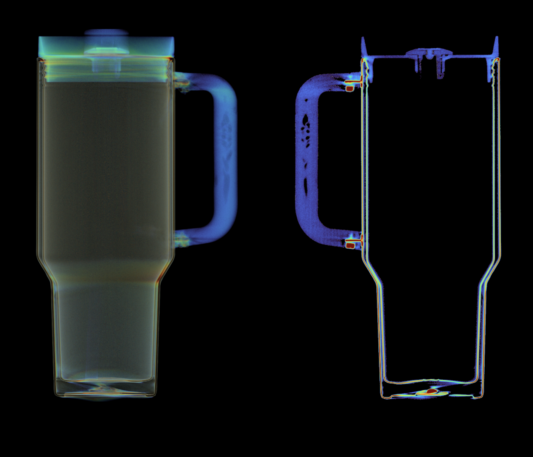This company took an X-ray of a Stanley cup to find that pesky lead
Look for the bright red dot.
The Stanley cup—darling of Target shoppers, Utah moms, and millennials everywhere—has been lauded online for more than a year after a new marketing strategy propelled the brand from a dated workman’s gear supplier to an influencer-driven hit. But, this January, several TikTokers started posting about their 40-ounce Stanley Quenchers testing positive for high levels of lead, putting a dent in the water bottle giant’s reputation.
In a statement to Today.com, a Stanley spokesperson clarified that, while a small amount of lead is used in the cup’s manufacturing process, “no lead is present on the surface of any Stanley product that comes into contact with the consumer nor the contents of the product.” Further, they noted that the only way to access the lead would be if a stainless steel medallion on the bottom of the cup popped off—a possible but “rare” occurrence.
Now, an industrial CT-scanning company has put Stanley’s claims to the test.
The company, Lumafield, used an X-ray CT scanner called Neptune to see below the Quencher’s surface. Neptune creates 3D models that are color-coded by material density and can be sliced to view internal cross-sections, allowing manufacturers to get a closer look inside their prototypes. But the tech is also useful for understanding products that are already on the market; in the past, Lumafield has scanned Heinz’s $1.2 million ketchup cap, Apple’s Thunderbolt cable, even a plain old football.
Lumafield’s new scans of the Stanley Quencher provide a detailed view of how the beloved tumbler is made. The images feature inner and outer stainless-steel walls separated by a vacuum that helps the liquid inside stay ice-cold. To create a sealed unit, the walls get welded together at the rim. The cup is placed in a vacuum chamber, and to create the empty space, the air inside the cup gets removed through a small hole. Then, manufacturers need a way to seal the gap. That’s where the lead comes in.
In the Neptune scans, a small red dot is visible at the bottom of the Quencher. This is the lead pellet that seals the cup’s vacuum, and it appears in a dark maroon hue because of its high density (lead is significantly denser than stainless steel and plastic, the cup’s main components). The lead is completely shielded from the actual interior of the cup by the vacuum and second steel layer, and the steel medallion covers it on the exterior, meaning that the lead won’t touch your drink or your hand.
According to Lumafield product lead Jon Bruner, it is possible to seal cups like these without lead. In fact, companies including Owala, Klean Kanteen, and Hydro Flask are all lead-free. But there are a few reasons why Stanley might have chosen to use the material.

“[One alternative is] lead-free solder, which is usually an alloy of several metals and maybe some proprietary additives here and there. It’s much trickier to use in an industrial process than leaded solder,” Bruner says. “Leaded solder melts at a very specific point, it flows well and bonds well to the materials around it. Lead-free solder tends to melt over a range of temperatures, so it’s tricky to dial it in.”
Sticking with the tried-and-true might be easier to control, but does this lead-pellet method make Stanley cups unsafe? The answer is almost definitely no. “The scan suggests that the cups are not a risk to consumers at a high level,” Bruner says. He adds that, even if the medallion were to come detached, a passing contact with lead solder isn’t something that would have “a big impact on your health.” If that does happen, Stanley will replace the defective item under the product’s lifetime warranty.
Although the average consumer can be confident that their Quencher doesn’t pose a health risk, it remains a mystery why many TikTokers’ bottles seemed to test positive for lead—but Bruner has some theories.
“I think there are a few alternative explanations,” he says. “One is that those take-home lead tests have a pretty high false-positive rate, so you could swab a bunch of things that don’t have lead and a certain number will turn up positive. Another would be that there’s lead in their drinking water, and after putting water in their cup, there’s a trace of lead in the cup. And another would be that maybe they pried the medallion off their cup in order to make a viral video.”
(29)